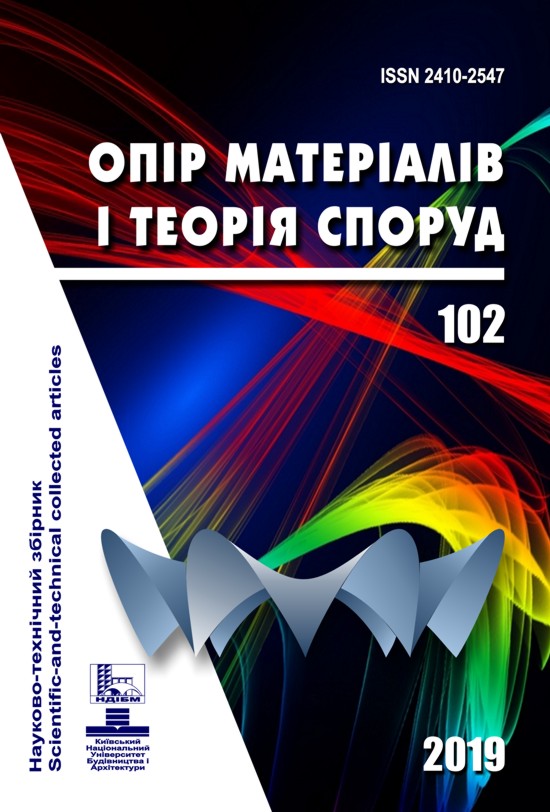Oscillations of aerodynamic constructions: safe speed band
DOI:
https://doi.org/10.32347/2410-2547.2019.102.121-138Keywords:
mathematical model, transonic flutter, aerodynamic profile, aerodynamic surface control, shock waves, transonic flow, Mach number flight, pressure of local supersonic flow, disturbing hinge momentAbstract
The article deals with the shock waves regularities interaction with the flutter angular speed of the aerodynamic surfaces control are established basing on the analysis of Bernoulli’s equation for compressible gas, the evaluation of changes of the supersonic flow characteristics in the Prandtl-Meyer expansion fan and the aerodynamic profile “dynamic curvature” hypothesis. The established regularities explain the cause of the disturbing forces and hinge moments of the supersonic aircraft aerodynamic surfaces control and aerospace systems at transonic flight speeds.
The mathematical models of estimation of the disturbing forces and the disturbing hinges magnitudes of the aerodynamic surfaces control are obtained basing on the established regularities of shock waves with interaction the flutter angular velocity of the aerodynamic surfaces control.
The dangerous range of Mach number flight is determined basing on a quantitative analysis of the obtained mathematical models and it is shown that the genesis of transonic flutter of supersonic aircraft and aerospace systems is possible in a narrow range of the Mach numbers flight.
Moreover, the range of the Mach numbers flight, in which there is an increase in the disturbing hinge moments of the aerodynamic surfaces control and in which the planes stay in the phase of flight speed reducing from supersonic to subsonic, is more than three times the range of the Mach numbers flight, in which the planes stay in the phase of the flight speed increasing from subsonic to supersonic. This result permits to explain one of the possible reasons why the transonic flutter occurrence of the supersonic aircraft is more often observed in the phase of flight speed reducing from supersonic to subsonic.
The obtained results can be used for a preliminary assessment of the transonic flutter characteristics of the supersonic aircraft aerodynamic surfaces control and aerospace systems, as well as the recommendations developing for flight personnel on the piloting features of supersonic aircraft at transonic flight speeds.
References
Aerodinamicheskoe issledovanie koleblucheisja poverchnоsti upravlenija pri transzvukovuch skorostjach. (1975). [Aerodynamic study of an oscillating control surface at transonic velocities], Moscow: TsAGI, No. 456, 105 р.
Kuzmina S.I. Raschetnie issledovaniya transzvukovogo flatera samoleta [Kuzmina S.I. The calculated analysis of aircraft transonic flutter / Kuzmina S.I. – M.: Central Institute of Aerohydrodynamics materials, Volume XX, No.6, 1989. p.110 – 115].
Semon B. I., Safronov A.V., Nedilko A.N. (2016). «Transzvukovjy flatter: vid MiG – 25 do Space Ship Two» [Transonic Flutter: from MiG-25 to Space Ship Two], Science and Defense, No. 3, pp. 32-35.
Safronov A.V. Aerodinamicheskoe vozdejstvie skashkov uplotnenija na koleblucheisja v okolozvukovom potoke eleron. [Safronov A. Aerodynamic impact of shock waves on aileron oscillating in a transonic flow on aileron / A. Safronov - Moscow: CAHI Notes, Vol. 21, No. 3, 1991, p. 110 - 117].
Safronov A.V. Usloviya vozniknoveniya avtokolebaniy aerodinamicheskix poverhnostey upravleniya pri bezotrivnom obtekanii okolozvukovim potokom gaza [Safronov A.V. The self-oscillations conditions of the aerodynamic surfaces control with the attached flow of near-transonic flowing gas / Safronov A. V. – К.: Strength of materials. No.2, 1990, p.50-55].
Safronov A.V., Nedilko A.N. (2016). Matematichna model ozinki maksimalno moglivih velichin sbudgenih charnirnih momentiv aerodinamichnich verchon keruvanna pri viniknenni transzvukovogo flateru [Mathematical model of estimation of maximum possible values of excited hinge moments of aerodynamic surfaces of control in the occurrence of transonic flutter], Science and Technology of the Air Force of Ukraine, No. 4(25), pp. 19-23.
Levkin V.F. (1982). Eksperimentalnue issledovaniija hestazionarnuch aerodinamicheskich charakteristik poverchnostej upravlenija pri transzvukovuch skorostjach [Experimental studies of non-stationary aerodynamic characteristics of control surfaces at transonic speeds], Papers of TsAGI, issue 2132, 16 p.
Isogai K. O mechanizme rezkogo snigenija granicsu flatera krula prjamoj strelovidnosti na regime transzvukovogo poleta. [Isogai K. On the mechanism of a sharp decrease in the flutter boundary of a straight sweep in a transonic flight mode. Part II / Isogai K. - M .: RTK, Vol. 19, No. 10, 1981. Pp. 169-171].
Goschek I. (1954). Aerodinamika bolshih skorostej. [Aerodynamics of high speeds], Moscow: IL, 547 p.
Svichev G.P. Effektivnost rylya I sharnirnie momrnti ego pri bolshix skorostyx [Svyshchev G.P. Efficiency of the steering wheel and its hinge moments at high speeds / Svyshchev G. P. - M .: Works of CAHI, issue 1722, 1975.– 10 p.].
Keldisch M.V. (1985). Izbrannie trudi. Mechanika. [Selected works. Mechanics], Moscow: Science, 568 p.
Aerodinamika letatelnich apparatov pri transzvukovuch skorostjach. [Aerodynamics of aircraft at transonic speeds. Part I. - M .: Reviews. Translations. Abstracts. CAHI, No. 441, 1974. - 140 p.].
Aerodinamika letatelnich apparatov pri transzvukovuch skorostjach. [Aerodynamics of aircraft at transonic speeds. Part II. - M .: Reviews. Translations. Abstracts. CAHI, No. 442, 1974. – 161 p.].
Abramovich G.N. Prikladnaja gazovaja dinamika [ Abramovich G. N. Applied gas dynamics / G. Abramovich N. - M .: Science, 1976. - 888 p.].
Vilyams M.H. Teoriya neystanovivshegocu lvigeniya tonkogo profilya v transzvukovom potoke s vnutrenimi skackami uplotneniya [Williams M. H. The unstable motion theory of the thin profile in the transonic flow with internal shock waves /. Williams M.H. – M.: Rocket Engineering and Space Technology, Volume 18, No. 7, 1980. – p. 11-23].
Downloads
Published
Issue
Section
License
Authors retain copyright and grant the journal right of first publication with the work simultaneously licensed under a Creative Commons Attribution License that allows others to share the work with an acknowledgement of the work's authorship and initial publication in this journal.

